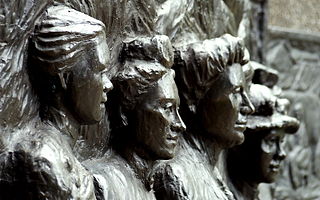
Katherine Wilson Sheppard was the most prominent member of the women's suffrage movement in New Zealand and the country's most famous suffragist. Born in Liverpool, England, she emigrated to New Zealand with her family in 1868. There she became an active member of various religious and social organisations, including the Women's Christian Temperance Union New Zealand. In 1887 she was appointed the WCTU NZ's National Superintendent for Franchise and Legislation, a position she used to advance the cause of women's suffrage in New Zealand.

Aotea Square is a large paved public area in the CBD of Auckland, New Zealand. Officially opened in 1979 by Sir Dove-Myer Robinson next to Queen Street, it is used for open-air concerts and gatherings, markets, and political rallies. In November 2010, a major redevelopment of Aotea Square was completed. The square was redesigned to make it appropriate for use by crowds of up to 20,000 people.

Auckland Art Gallery Toi o Tāmaki is the principal public gallery in Auckland, New Zealand. It has the most extensive collection of national and international art in New Zealand and frequently hosts travelling international exhibitions.

Shane William Cotton is a New Zealand painter whose work explores biculturalism, colonialism, cultural identity, Māori spirituality, and life and death.

Women's suffrage was an important political issue in the late-nineteenth-century New Zealand. In early colonial New Zealand, as in European societies, women were excluded from any involvement in politics. Public opinion began to change in the latter half of the nineteenth century and after years of effort by women's suffrage campaigners, led by Kate Sheppard, New Zealand became the first nation in the world in which all women had the right to vote in parliamentary elections.

The Auckland Central Business District (CBD), or Auckland city centre, is the geographical and economic heart of the Auckland metropolitan area. It is the area in which Auckland was established in 1840, by William Hobson on land gifted by mana whenuahapū Ngāti Whātua Ōrākei. It is New Zealand's leading financial hub, and the centre of the country's economy; the GDP of the Auckland Region was NZD$139 billion in the year ending September 2023.

The Aotea Centre is a performing arts and events centre in Auckland, New Zealand. Located at the western edge of Aotea Square, off Queen Street, the centre provides a cultural, entertainment and conventions venue space in the heart of the city, and is managed by Auckland Unlimited. The origin of its name is Motu Aotea, the Māori name for Great Barrier Island, which is the largest offshore island of New Zealand and approximately 90 km from downtown Auckland.
Dame Cheryll Beatrice Sotheran was a New Zealand museum professional. She was the founding chief executive of the Museum of New Zealand Te Papa Tongarewa and was credited with the successful completion of the museum, considered the largest international museum project of the 1990s.

Symonds Street Cemetery is a historic cemetery and park in central Auckland, New Zealand. It is in 5.8 hectares of deciduous forest on the western slope of Grafton Gully, by the corner of Symonds Street and Karangahape Road, and is crossed by the Grafton Bridge. The street is named for William Cornwallis Symonds, a British Army officer prominent in the early colonisation of New Zealand. It has a Historic Place – Category I listing with the New Zealand Historic Places Trust. Maintenance and administration of the cemetery is provided by the Auckland Council.

The Dowse Art Museum is a municipal art gallery in Lower Hutt, New Zealand.

Anne Ward was the first national president of the Women's Christian Temperance Union New Zealand from 1885 to 1887, and a prominent member of the women's suffrage movement in New Zealand.
Sopolemalama Filipe Tohi is a Tongan artist who has lived in New Zealand since 1978. He has exhibited in major exhibitions in New Zealand and abroad. Several major collections include his work. The 2010 Art and Asia Pacific Almanac describes him as "Tongan art's foremost ambassador".

The Kate Sheppard National Memorial, located in the city of Christchurch, is New Zealand's first memorial to the women's suffrage campaign, and particularly honours the life of one of the country's leading campaigners for women's suffrage, Kate Sheppard.
Carole Marie Shepheard is a New Zealand artist. She specialises in printmaking and her work is held in national and international collections including the Museum of New Zealand Te Papa Tongarewa and the Auckland Art Gallery Toi o Tāmaki.
Claudia Pond Eyley is a New Zealand artist and filmmaker. Her works are held in the collection of the Auckland Art Gallery Toi o Tāmaki and Museum of New Zealand Te Papa Tongarewa.
Mary-Louise Browne is a New Zealand artist, best known for her public word ladders, and other works using text. Her works are held in the permanent collections of the Te Papa, Auckland Art Gallery and the Govett-Brewster Art Gallery.

Women's Christian Temperance Union of New Zealand is a non-partisan, non-denominational, and non-profit organisation that is the oldest continuously active national organisation of women in New Zealand. The national organisation began in 1885 during the visit to New Zealand by Mary Clement Leavitt, the first world missionary for the Woman's Christian Temperance Union. The WCTU NZ was an early branch of the World Woman's Christian Temperance Union and a founding affiliate of the National Council of Women of New Zealand. Men may join the WCTU NZ as honorary members.

Fanny Buttery Cole was a prominent temperance leader and women's rights advocate in New Zealand. Cole was a founding member then president of the Christchurch chapter of the Women's Christian Temperance Union New Zealand and national WCTU NZ superintendent of the Press from 1897 through 1903. In 1906 Cole was elected national president of the WCTU NZ, a position she held until her untimely death shortly before her fifty-third birthday.














